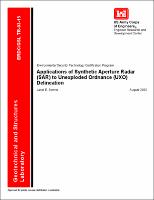Please use this identifier to cite or link to this item:
https://hdl.handle.net/11681/10507| Title: | Applications of synthetic Aperture Radar (SAR) to Unexploded Ordnance (UXO) delineation |
| Authors: | Environmental Security Technology Certification Program (U.S.) Simms, Janet E. |
| Keywords: | Foliage penetration Geophysics SAR Synthetic aperture radar Unexploded ordnance Munitions UXO |
| Publisher: | Geotechnical and Structures Laboratory (U.S.) Engineer Research and Development Center (U.S.) |
| Series/Report no.: | ERDC/GSL TR ; 03-15. |
| Description: | Technical Report Abstract: The Environmental Security Technology Certification Program (ESTCP) provided funding to determine the feasibility of using a foliage penetration (FOPEN) synthetic aperture radar (SAR) system to delineate unexploded ordnance (UXO) contaminated areas. The FOPEN SAR system was developed under a program funded by the Defense Advanced Research Projects Agency (DARPA), Army, and Air Force. The U.S. Army Engineer Research and Development Center coordinated the project efforts, which included participation of the Massachusetts Institute of Technology Lincoln Laboratory, Duke University, and the U.S. Army Research Laboratory. The objective was to measure UXO target signatures in varying target placement conditions, including target orientation, proximity to other targets, and foliage coverage. Three target sizes were imaged; 155-mm projectiles and simulants representing a 2000-lb bomb and 500-lb bomb. Large targets (bomb-size) and dense collections of smaller (155-mm) targets can be detected by the UHF FOPEN SAR when located on the ground surface within sparsely vegetated areas. Multiple aircraft headings will likely increase the chance of imaging UXO. Trees proximal to targets degraded the target resolution and no targets under foliage were able to be resolved. Environmental restrictions at the test site (Camp Navajo, Arizona) prohibited the burying of targets so no statements regarding the FOPEN SAR imaging capabilities of buried UXO can be made. The FOPEN SAR is not optimized for UXO detection. Optimizing the frequency range of a SAR system and exploiting polarization and angle-dependent scattering features may allow separation of UXO from clutter. |
| Rights: | Approved for public release; distribution is unlimited. |
| URI: | http://hdl.handle.net/11681/10507 |
| Appears in Collections: | Technical Report |
